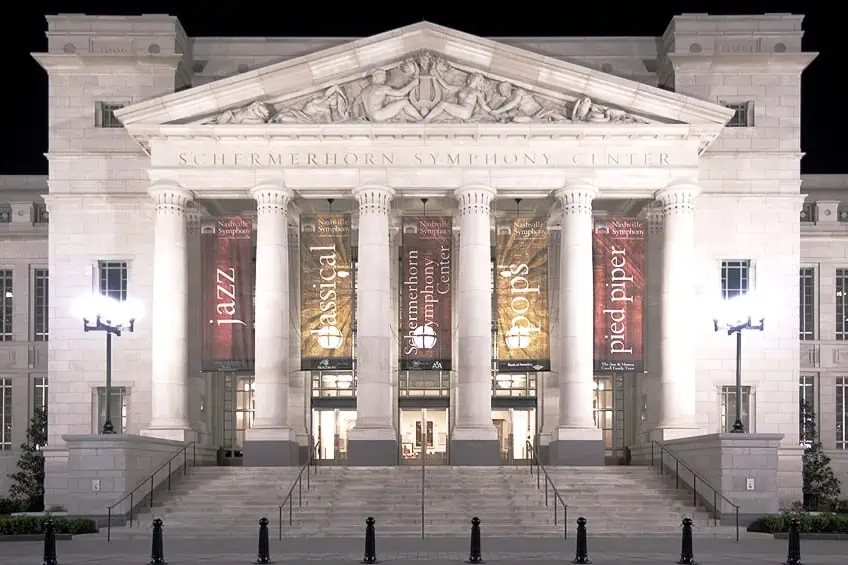Classical Architecture – Elegance Through the Ages
Classical architecture in general is likely the most influential form of architecture in the Western world. It started so long ago yet has gone on to inspire practically every other architectural style that followed it. This article will examine some of the major Classical architecture elements, the history of the Classical period and its aftermath, and a look at several Classical buildings. Keep reading to learn a lot more about this immensely influential style of architecture.
A Look at Classical Architecture
The term “Classical architecture” is a bit of a difficult one as it encompasses an immensely large time period from the 5th century BCE to the fall of the Western Roman Empire in 476 CE. The Classical period includes the Ancient Greek and Roman Empires while Classical architecture is everything that has been influenced by those forms. The idea is that many aspects of the Classical period were rediscovered and then architects attempted to reimplement the concepts and theories that were expressed during this age of antiquity.
While Ancient Greece is certainly included in the immense influence that the Classical period would have, it was the Ancient Roman civilization that truly influenced many of the subsequent architectural movements in the Western world.
The styles that dominated European architecture ever since the Renaissance are especially reliant on Classical architecture elements, but there are actually architectural influences in times before the Renaissance. There are certain Classical elements in Byzantine, Romanesque, and Gothic architecture, but the difference is that these architectural eras were not actively trying to emulate the past but were instead influenced simply by their proximity to the Classical era. This is also why the label of “Classical architecture” is such a difficult one. There are many forms of it, and there has been revival after revival, such as Neoclassical and Renaissance architectures. These are their own varieties, but they drew heavily from what had come before. However, this is not the final thorn in the side that the term “classical” in general implies.
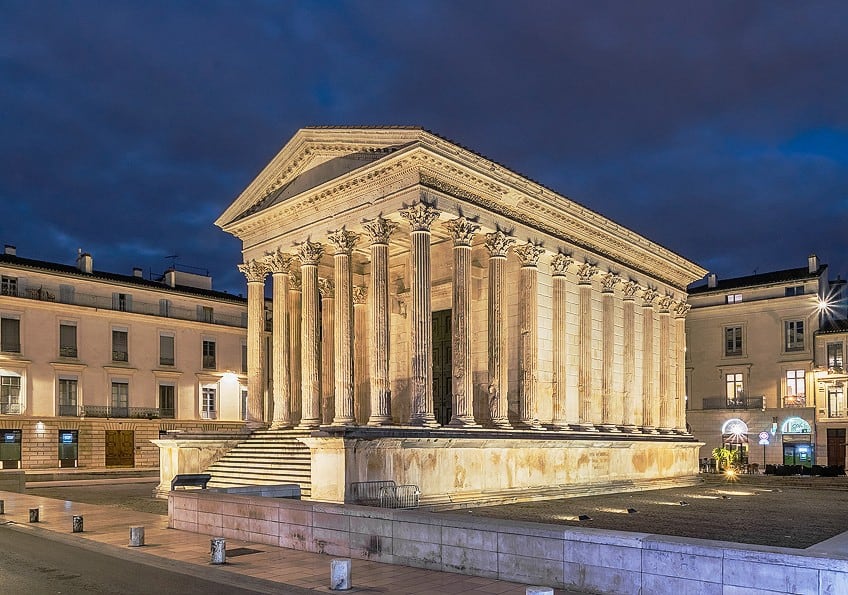
The word “Classical architecture” can also apply to practically any form of architecture that is, in some way, the heightened version of itself, such as classical Mayan architecture or classical Chinese architecture. These forms of architecture were not influenced by the Western Classical period, but they are the most refined forms of themselves. We will, for the purposes of this discussion, stick to the more Western-centric interpretation of the term. So, let’s have a look at some Western Classical architecture.
The History of Classical Architecture
Classical architecture, as is commonly known, arose in Ancient Greece and Rome, but then when the Western Roman Empire fell in 476 CE, the many architectural elements of these Classical periods would fade away. The Eastern Roman Empire became the Byzantine Empire, and it developed its own distinct style. However, that style was still reminiscent of the Classical period that had come before. So, it was a separate period, but it still held onto certain Classical elements. Then the Carolingian Empire developed its own style, and this empire would produce its own pre-Romanesque form of architecture that inherently attempted to emulate the Classical period. It certainly had its own unique aspects, but it was another of the styles that were supposedly distinct yet had many Classical architecture elements throughout its design.
Some of the biggest architects of the period were specifically influenced by Classical architecture.
Things then changed during the Renaissance period as a whole. This period ranged from 1400-1600 CE, and it would see the end of the Gothic style that had been so prevalent before it. The discovery of Vitruvius’s famous text, De architectura, led to the beginnings of major architectural theory in the Western world, and the Renaissance architects would attempt to copy what had come before. Even styles that may not appear necessarily Classical in their design, like Baroque and Rococo architecture, took a lot from the Classical period even though they would make substantial changes to what came before.
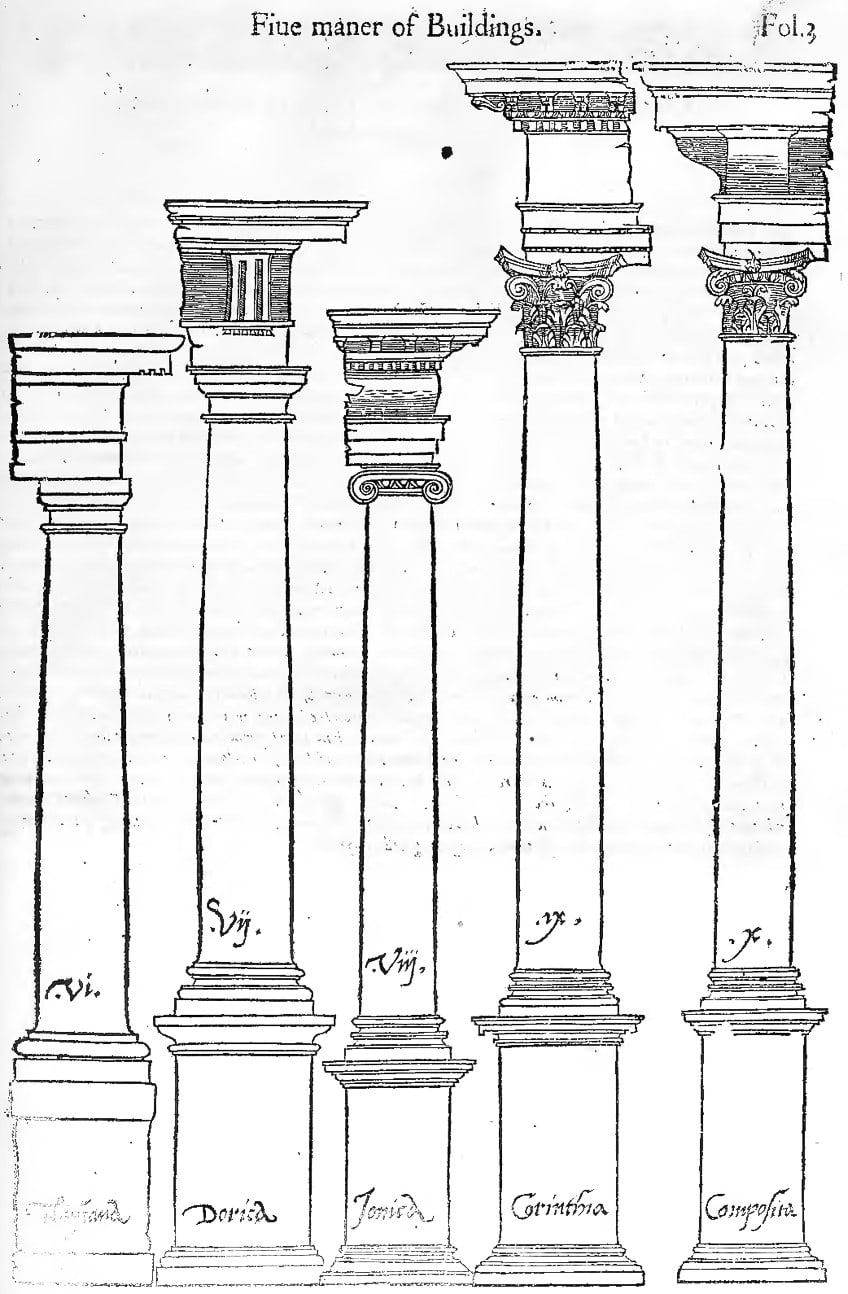
Other styles like Palladian architecture, which was derived from the work of one architect named Andrea Palladio (1508–1580), and his particular version of architecture maintain a dedication to symmetrical design and perspective while also retaining as many of the Classical traditions as it could. This would go on to have a major impact on the Late Renaissance architects. Then, in opposition to styles like Baroque and Rococo architecture, a more austere form of Classical revival was created. This is known as Neoclassicism, and it attempted to copy elements of the Classical period that had been discovered through the recent developments that had been made in the archaeology of the antique world.
This style wanted to be based on these ancient principal elements to be regarded as equally principled as the now revered Classical period.
Then things changed with the development of Modernism in the early years of the 20th century. There can be arguments made that the Classical styles of architecture stopped during this era, but that isn’t entirely true. While it is true that Modern architecture would go on to absolutely dominate the world, various revivals of Classical architecture have come over and over again. There are styles like Contemporary Classical architecture, which is a contemporary form of a Classical revival, and while it may not be as prominent as it was once, it certainly does still exist. So, remnants of Classical architecture exist to this day, because the style is beloved enough that it has come back to us repeatedly over centuries of history. So, let’s look at the most common elements of Classical architecture.

Classical Architecture Elements
The Classical period made use of a variety of innovations and then, during all the other interpretations of the Classical style that would follow, these elements were often reinterpreted and reused. The Ancient Greeks, for instance, are known for their column designs that used a post-and-lintel structure for the construction of buildings, and the use of columns would transcend the Ancient Greeks and become a principal component of Roman architecture too. However, the Romans also added a large array of other innovations like arches, aqueducts, and concrete.
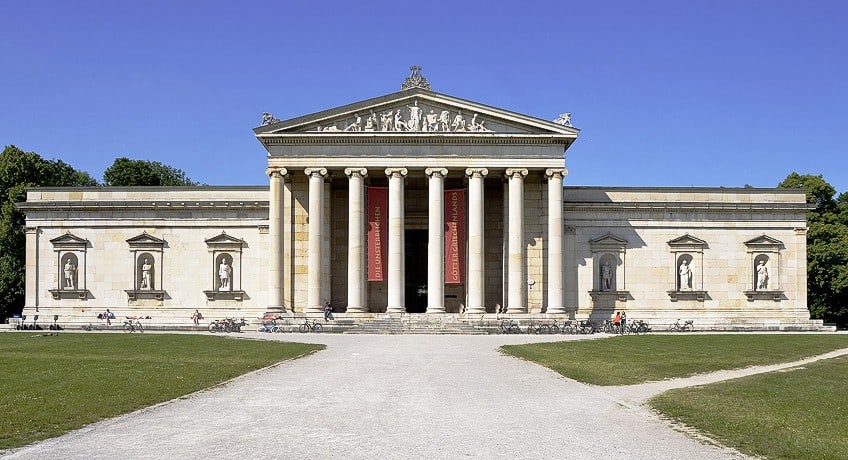
Many of the later styles that would be inspired by Classical architecture made use of an often oversimplified form of the original Classical architecture elements. However, these new interpretations would go on to differ from one Classical-inspired architectural era to the next. So, there cannot be a comprehensive list of all the major architectural elements without having to make slight alterations based on the specific differences between different revival styles. Let’s look at some of the primary elements though, but it must just be remembered that the different revivals of Classical architecture would use these basic elements in different ways:
- The use of Classical orders of column design. These include the Doric, Ionic, and Corinthian orders from the Ancient Greek era and the Tuscan and Composite orders from the Roman era.
- A sense of symmetrical design in which structures were often built around a central vertical axis to provide a symmetrical façade and other features. Many Classical buildings made use of symmetry, and the revivals wanted to emulate this.
- The creation of proportional structures that were, especially during the Renaissance era, designed around specific proportions of different elements to one another. So, the columns would be a certain size, and this would then be matched by the entablature above it.
These are some of the major characteristics that would become major aspects of various forms of Classically inspired structures. There were always differences between the different styles that would come from Classical architecture, but they would always follow these characteristics in some sense or another.
Famous Classical Architects
One can always benefit from learning about the architects who had a profound influence on styles such as this before progressing to what they actually designed. So, let’s have a look at three of the architects who had an especially large influence on Classical and Classical-style architecture. One cannot discuss Classical architecture without mentioning Vitruvius (80/70 BCE – 15 CE). This Ancient Roman architect and engineer may have operated under the rule of Julius Caesar himself, and he is predominantly known because he wrote a widely influential text on architectural theory called De architectura. The manuscript for this text was only rediscovered during the Renaissance, and this was one of the things that spurred the contemporary architects of the time to emulate the Classical style.
In addition, he is the originator of the architectural concept of all buildings requiring strength, utility, and beauty. All of this would have a profound influence on those who would follow.
Odo of Metz (742 – 814) was an architect who lived and operated during the Carolingian Empire, and he specifically worked under the Holy Roman Emperor Charlemagne’s reign. He designed structures like the Basilica of San Vitale of Ravenna and Charlemagne’s Palace of Aachen, and he would go on to become the principal influence that used late Roman architecture during the Byzantine era.

Andrea Palladio (1508 – 1580) was an architect who operated during the Italian Renaissance, and he was predominantly inspired by the work of Vitruvius, and so he pushed a fundamentally Classical style of architecture that would go on to influence many other Renaissance architects and artists. He designed many churches, palaces, villas, and country houses throughout his life. Each of these architects is often stated to have used Classical architecture elements, so what are those elements? What actually makes something Classical, or inspired by Classical architecture, rather than non-Classical? Keep reading to find out.
Examples of Classical Buildings
We will consider several pieces of classic architecture below. These classical buildings are some examples from across the ages. They start from 421 BCE all the way until one of the latest pieces of classically inspired architecture that were constructed by 2005.
This form of architecture has lasted a long time, and it will continue to survive long past the initial classical period.
Erechtheion (421 – 406 BCE) in Athens
| Architect | Unknown |
| Date Constructed | 421 – 406 BCE |
| Function | Temple |
| Location | Athens, Greece |
The Erechtheion is an ancient temple-telesterion structure that adopts the Ancient Greek Ionic order of columns. It is one of the most famous structures to adopt this particular order, and the building served as both a temple and a telesterion. A temple is, as most would likely know, a place of worship. However, a telesterion is a lesser-known structure and it is effectively a large hall that is covered with a roof. It was used as a gathering place with a somewhat unknown exact purpose. This Ancient Greek temple was also known as the Temple of Athena Polias. It was constructed on the Acropolis during the Bronze Age Mycenaean period in Ancient Greece. However, it has been subjected to one series of damage and repair after another.
It was first damaged by a fire somewhere between 377-376, but there was an even worse fire that ravaged the area in the 1st century BCE. It was after this second, larger fire that true reconstruction began.
Much like the Parthenon, the Erechtheion was severely damaged at some point in time between the 3rd and 4th centuries CE. We do not know the exact cause of this damage, but it could have been because of Visigoth or Herulian attacks, or perhaps even a natural disaster. We simply do not know this for sure. What we do know is that the Erechtheion was a classical building that saw a large number of changes over the course of its existence. It was turned into a Christian church at one point, gained a pillared hall with a vaulted roof, and was even transformed into a basilica church during the late 6th or 7th centuries. It would eventually become deconsecrated and instead used as a residence before finally becoming an Ottoman structure that was, possibly, used as a harem. There is much dispute about this though.
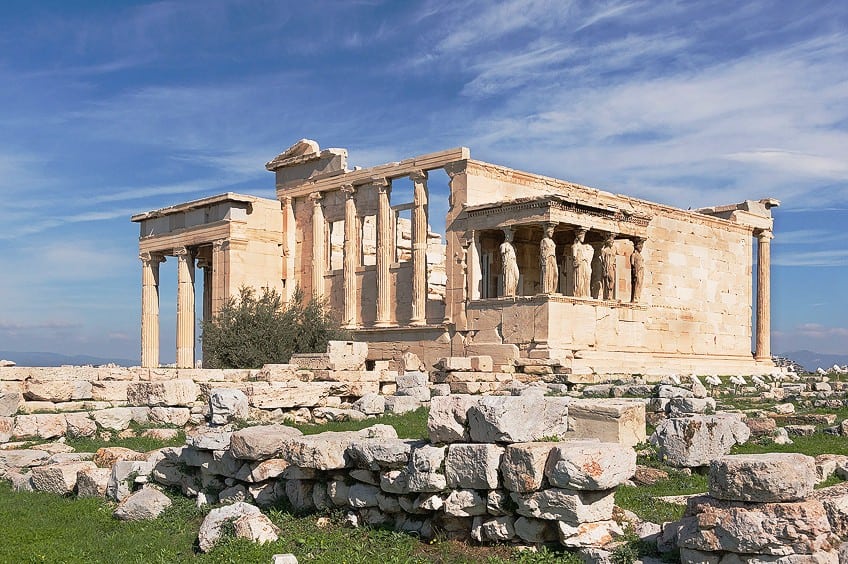
However, this history does not encompass why the Erechtheion was such an important structure in classical architecture. It was an extremely unique building in Ancient Greek society as it made use of an asymmetrical design that was antithetical to so much Ancient Greek architecture that had come before and after it. This irregular structure may have been because of the changing nature of the cults that had control of the building or it may have been an ultimately incomplete structure that would have eventually become symmetrical. We do not have the kinds of records to know anything of this nature for certain, however, the Erechtheion is considered to be a phenomenal example of classic architecture. It influenced many that came after it, such as the Hellenistic society that followed it, the Romans, and, of course, all the Greek revival styles that would eventually follow in its wake.
This classical building is one of the most important in the world and would go on to influence many of those that would follow in the wake of the architecture of antiquity.
Lorsch Abbey Gatehouse (Roughly 764) in Lorsch
| Architect | Rupertiner Williswinda (8th Century) |
| Date Constructed | Roughly 764 |
| Function | Abbey |
| Location | Lorsch, Germany |
The Lorsch Abbey Gatehouse is the gatehouse for the predominantly ruined Imperial Abbey of Lorsch. This ancient abbey is mostly a destroyed structure by today, but it has gone on to become an incredibly influential example of the style that was prominently used throughout the Carolingian Empire. This was a pre-Romanesque style structure that attempted to implement something of a Greek revival. This particular gatehouse is one of the only remaining buildings from this era, and so even in an utterly ruined state, it is an integral part of the history of this region and that particular period of time. While the abbey itself, which was one of the most renowned of its kind in the Carolingian Empire, is mostly a destroyed structure by now, the gatehouse is intact.
This gatehouse has a triple-arched hallway that comprises the structure, and there is an arched façade that makes use of both classical columns and pilasters, which are non-load-bearing columns that are made to look like columns while having no real functional use.
This abbey, with its gatehouse, has served as architectural evidence of the beginnings of the Holy Roman Empire, as the Carolingian Empire was under the might of the unifying force of the Holy Roman Emperor Charlamagne. Sadly, the monastery would be hit with a massive fire in 1090, although there was a subsequent attempt to restore the structure, it would eventually fall into disrepair.
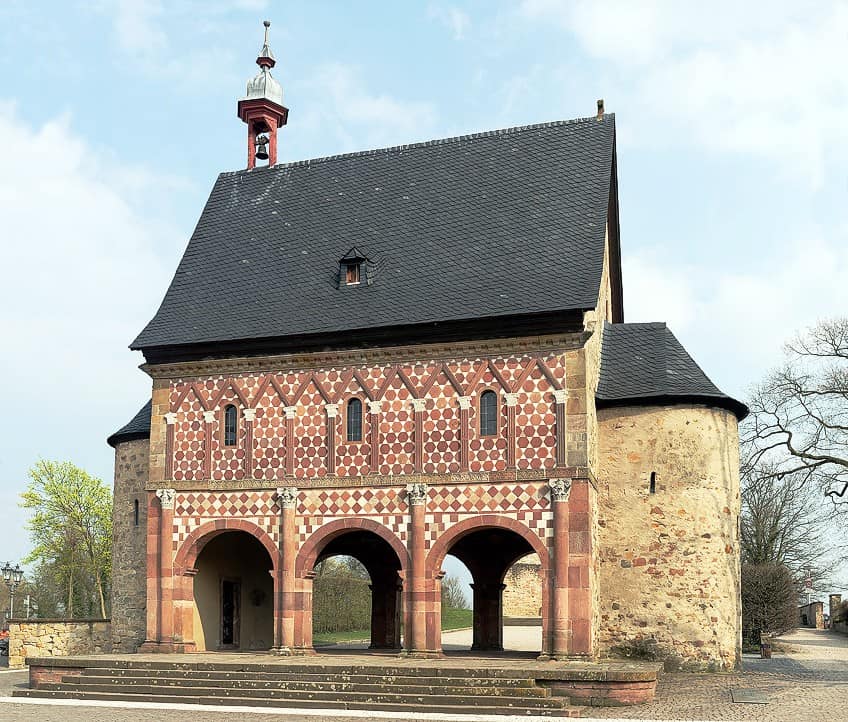
The gatehouse stands as some of the final architectural aspects of an era in which the Carolingian Empire, under Charlemagne and his successors, would dominate the politics of Europe. Today, it is little more than a ruin.
Santa Maria Nova (1578 – 1590) in Vicenza
| Architect | Andrea Palladio (1508 – 1580) |
| Date Constructed | 1578 – 1590 |
| Function | Church |
| Location | Vicenza, Italy |
The Santa Maria Nova is a Roman Catholic church located in Vicenza, Italy. This church is of particular importance because of its place as a piece designed by Andrea Palladio. Palladio was a Renaissance architect and one of the most influential during that era. He would make many structures throughout his life, and his buildings became known for a distinct architectural style known as Palladian architecture. This style was directly influenced by the Ancient Greek and Roman examples of antiquity, and it was focused on ideas surrounding symmetry and perspective as favored by the Greeks and Romans that inspired Palladio’s work.
It isn’t often that an architectural style originates in one person and then expands far beyond their short mortal existence, but this was the case with Andrea Palladio.
In this particular case, the Santa Maria Nova was a church that was funded by Lodovico Trento, a nobleman from the city, and he wanted a reconstruction of the church that was adjacent to an old Augustinian convent. It was designed in the characteristic Palladian style that included a variety of wall and ceiling paintings that were produced by several famed Renaissance artists in the city such as Andrea Vicentino and Alessandro Maganza.

It would go on to be the only church design in Vicenza that is known to have been produced by Andrea Palladio. However, he did also design a few other things in the city, such as the Valmarana chapel in Santa Corona, as well as the portal of the Santa Maria dei Servi. This church has remained, to this day, as a stunning example of a Classical style of architecture.
Virginia State Capitol (1785 – 1788) in Richmond
| Architect | Thomas Jefferson (1743 – 1826) and Charles-Louis Clérisseau (1721 – 1820) |
| Date Constructed | 1785 – 1788 |
| Function | Governmental building |
| Location | Richmond, Virginia, United States |
The Virginia State Capitol is a magnificent example of a classically designed building that was constructed long after the classical period actually came to an end. It is located in Virginia, United States, and served as the home of the oldest elected legislative body in the entirety of North America. This legislative body was actually first established in 1619, but it eventually transferred over to this classical building after its construction in 1788. One of the most interesting aspects of this building is that it was designed, in part, by Thomas Jefferson. He may have been the third President of the United States, but he was also actually an architect who used the Palladian architectural style that was initially developed by Andrea Palladio, as discussed under the previous building.
Jefferson would design this building to house the legislation of the state, but the building was also actually used as the Capitol of the Confederacy during the American Civil War of 1861-1865.
This would lead to the building gaining a certain level of notoriety in the subsequent decades after the war had come to an end. Another major incident occurred on 27 April 1870. There is a large courtroom on the second floor of this classical-style building and during a set of planned proceedings, after hundreds had filed into the room, the gallery crashed into the ground and, because of the extensive weight and force of it, the floor broke away and crumbled. This devastating event would lead to the deaths of 62 people, while a further 251 were injured, as they plummeted to the first floor from a height of 12 m (or 40 ft).
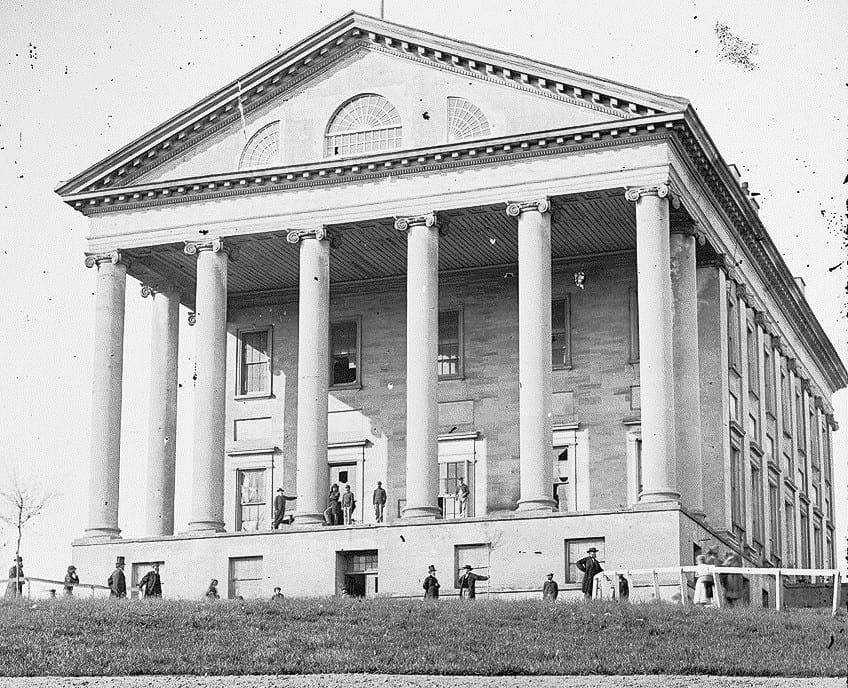
This event would lead to pandemonium around the Capitol building as people struggled to escape the destruction, and this catastrophe would eventually lead to many people wanting this building to be pulled down. This never happened. Instead, the Virginia State Capitol was expanded in 1904 as two new wings were added. These wings led to the present architectural design of the structure. These new wings were needed for the growing nature of this legislative body in Virginia. The tragedy of the collapse was all but forgotten as everyone went about their political lives once again. But why did this building in the middle of the United States in the late 18th century have a style reminiscent of Classical architecture with its white surface and column-oriented design?
The reason is that this building was conceived during a meeting between Thomas Jefferson and Charles-Louis Clérisseau while the pair of them were in France.
They were inspired by the sight of the Maison Carrée in Nîmes, France. This is an Ancient Roman temple that features a design very similar to the overall design that would come to be known throughout the American State of Virginia as indicative of their capitol building. The general design made use of an Ionic rather than Corinthian order that can be found on the inspiration structure in France. They opted for a particular variety of the Ionic order that was designed by Vincenzo Scamozzi, an architect who was the student of the famous originator of the Palladian architecture that Jefferson was especially fond of, Andrea Palladio.
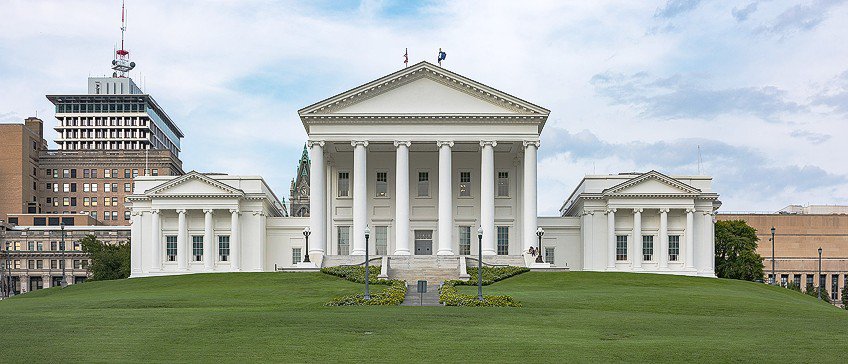
This classically inspired structure has gone on to become one of the most important works of classical architecture in the post-classical era. In many ways, it ushered in the Neoclassical style that would become more widely adopted in the United States, a style that would go on to adorn the presidential residence itself, The White House.
Schermerhorn Symphony Center (2003 – 2005) in Nashville
| Architect | Earl Swensson Associates, David M. Schwarz Architects, and Hastings Architecture Associates |
| Date Constructed | 2003 – 2005 |
| Function | Concert hall |
| Location | Nashville, Tennessee, United States |
The Schermerhorn Symphony Center is the most recent example of a building inspired by Classical architecture on this particular list. The name itself may seem a little strange for the region, as this building is located in the United States, but the name comes from the former music director and conductor of the Nashville Symphony, Kenneth Schermerhorn. He held this position from 1983 all the way until 2005, the year in which he passed away. The building was named before his death. There is no especially prevalent historical context to this building or why it was built. There needed to be a new concert hall, and so they built one. However, it has become known for its immensely Classical design that makes it appear as if it’s something out of the Ancient Greek era.
However, this pseudo-Classical building was instead completed in 2005. So, it’s only off from the Ancient Greek era by about 2000 years.
The façade of this concert hall is immensely reminiscent of the kinds of structure that have become synonymous with Classical architecture. It makes use of a modernized version of Ancient Greek columns that do not neatly conform to the primary archetypical orders of the Classical era. Instead, it emulates the kind of detailed entablature found in similar Classical buildings to present the image of age and illustriousness while being a modern building designed using modern sensibilities.
The interior of the Schermerhorn Symphony Center especially betrays this reality in the use of natural lighting that is filtered through double-paneled and soundproof windows while also employing technological and acoustical innovations that have resulted in the building containing a vast array of motorized seats on the ground floor that allow the entire structure to be turned into a ballroom if the need were to arise.
Underneath the typical seating area, there is a Brazilian cherry and hickory parquet floor that is perfect for dancing the night away.
In addition to this technological design, which is not exactly in keeping with standard Classical architecture elements, the building also includes many highly intricate designs throughout the structure. These include designs based on irises (which is the state flower of Tennessee), coffee beans (which is a reference to the Cheek family in Nashville, which is a family that played a major role in the development of the Nashville Symphony), and horseshoes (as they are used as a dedication to Laura Turner after whom the central hall is in this structure is named, who was in love with horses). Finally, there is a public garden beside the concert hall known as the Martha Rivers Ingram Garden Courtyard.

It is enclosed by a colonnade that further emphasizes the Classical architectural influences that led to this building’s construction. A construction that would complement the other Classical and Neoclassical buildings that could be found throughout the city, such as the true-to-life Parthenon that was built in Nashville’s Centennial Park in 1897 (and made permanent by 1931). So, the Schermerhorn Symphony Center is continuing a trend that has been prevalent in the Tennessee city of Nashville for over a century.
Thus we come to the end of our discussion of Classical architecture and its descent through the ages as it influenced numerous styles along the way. We looked at the origins of this style, some of its primary characteristics and architects, and finally ended off with a look at a few buildings that have adopted classical architecture elements through the centuries. Hopefully, this has all meant an enjoyable read for those who had a look at this article.
Frequently Asked Questions
What Is Classicism Architecture?
Classical architecture, also known as Classicism architecture, is a form of architecture that is, in some way, inspired by the Classical Period. This was the period that included the Ancient Greeks and the Ancient Romans. The Roman influence tends to be more prevalent in later Classical structures, but there can be no Roman architecture without Ancient Greek architecture.
What Are the Main Classical Architecture Elements?
Classical architecture has several major elements that are typically followed in many different iterations of this famous style of architecture. Classic architecture made extensive use of the three primary, and two additional, orders of columns, while also presenting a focus on symmetrical elements and proportionality.
How Many Architectural Styles Have Been Influenced by Classicism?
This is impossible to know, as the Classical period had such a profound impact, from both an architectural and non-architectural perspective, on the rest of Western society. So, there may have been Classical influences in smaller and lesser-known styles that have faded from collective human knowledge thanks to a lack of record-keeping during ancient historical periods.
Justin van Huyssteen is a writer, academic, and educator from Cape Town, South Africa. He holds a master’s degree in Theory of Literature. His primary focus in this field is the analysis of artistic objects through a number of theoretical lenses. His predominant theoretical areas of interest include narratology and critical theory in general, with a particular focus on animal studies. Other than academia, he is a novelist, game reviewer, and freelance writer. Justin’s preferred architectural movements include the more modern and postmodern types of architecture, such as Bauhaus, Art Nouveau, Art Deco, Brutalist, and Futurist varieties like sustainable architecture. Justin is working for artfilemagazine as an author and content writer since 2022. He is responsible for all blog posts about architecture.
Learn more about Justin van Huyssteen and about us.
Cite this Article
Justin, van Huyssteen, “Classical Architecture – Elegance Through the Ages.” artfilemagazine – Your Online Art Source. October 18, 2023. URL: https://artfilemagazine.com/classical-architecture/
van Huyssteen, J. (2023, 18 October). Classical Architecture – Elegance Through the Ages. artfilemagazine – Your Online Art Source. https://artfilemagazine.com/classical-architecture/
van Huyssteen, Justin. “Classical Architecture – Elegance Through the Ages.” artfilemagazine – Your Online Art Source, October 18, 2023. https://artfilemagazine.com/classical-architecture/.


